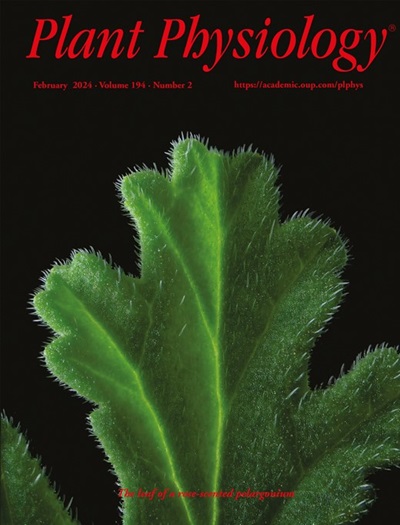类似亮氨酸-丰富重复受体的激酶调控水稻花粉孔的形成
IF 6.5
1区 生物学
Q1 PLANT SCIENCES
引用次数: 0
摘要
花粉粒中的孔呈现出物种特异性模式,为研究细胞表面模式化提供了一个理想模型。花粉孔对于谷类作物的生育至关重要,虽然有文献记载 DEFECTIVE IN APERTURE FORMATION1(OsDAF1)和 INAPERTURATE POLLEN1(OsINP1)参与了水稻(Oryza sativa)花粉孔的形成,但调控花粉孔形成的分子传导途径在很大程度上还不为人所知。在这里,我们报告了一种类似亮氨酸-丰富重复受体的激酶(LRR-RLK)--AM1--在水稻花粉孔形成过程中起着关键作用。OsAM1 基因突变会导致花粉孔消失和花粉管发芽失败,从而导致完全不育。OsAM1 编码的 LRR-RLK 属于 STRUBBELIG 受体家族。与其他已报道的孔口调节因子类似,OsAM1 在减数分裂后集结到四分体上的未来孔口位点,以调节孔口的形成。OsAM1 的细胞外结构域和细胞内结构域分别与 OsINP1 和 OsDAF1 相互作用。然而,尽管Osam1花粉粒与OsINP1和OsDAF1相互作用且没有孔道形成,但在四分体阶段,OsINP1和OsDAF1会定位到未来的孔道部位。然而,OsINP1 的突变会破坏 OsAM1 的正常定位,这表明 OsAM1 在 OsINP1 的下游发挥作用。我们的发现揭示了 LRR-RLK 蛋白在花粉孔形成中的作用,并揭示了花粉孔形成的调控网络。本文章由计算机程序翻译,如有差异,请以英文原文为准。
A leucine-rich-repeat receptor-like kinase regulates pollen aperture formation in rice
Apertures in pollen grains exhibit species-specific patterns and provide an ideal model for studying cell-surface patterning. Pollen apertures are critical for cereal crop fertility, and while DEFECTIVE IN APERTURE FORMATION1 (OsDAF1) and INAPERTURATE POLLEN1 (OsINP1) have been documented to participate in pollen aperture formation in rice (Oryza sativa), the molecular transduction pathway regulating aperture formation is largely unknown. Here, we report that a leucine-rich-repeat receptor-like kinase (LRR-RLK), AM1, plays a key role in rice pollen aperture formation. Mutations of OsAM1 lead to complete sterility due to disappearance of the pollen aperture and failure in pollen tube germination. OsAM1 encodes a LRR-RLK that belongs to the STRUBBELIG-receptor family. Similar to other reported aperture regulators, OsAM1 assembles to future aperture sites on tetrads after meiosis to regulate aperture formation. The extracellular and intracellular domain of OsAM1 interacts with OsINP1 and OsDAF1, respectively. However, despite their interaction and the absence of aperture formation in osam1 pollen grains, OsINP1 and OsDAF1 localize to future aperture sites at the tetrad stage. Mutation of OsINP1, however, disrupts normal localization of OsAM1, indicating that OsAM1 acts downstream of OsINP1. Our findings reveal the role of a LRR-RLK protein in pollen aperture formation and shed light on the regulatory network of pollen aperture formation.
求助全文
通过发布文献求助,成功后即可免费获取论文全文。
去求助
来源期刊

Plant Physiology
生物-植物科学
CiteScore
12.20
自引率
5.40%
发文量
535
审稿时长
2.3 months
期刊介绍:
Plant Physiology® is a distinguished and highly respected journal with a rich history dating back to its establishment in 1926. It stands as a leading international publication in the field of plant biology, covering a comprehensive range of topics from the molecular and structural aspects of plant life to systems biology and ecophysiology. Recognized as the most highly cited journal in plant sciences, Plant Physiology® is a testament to its commitment to excellence and the dissemination of groundbreaking research.
As the official publication of the American Society of Plant Biologists, Plant Physiology® upholds rigorous peer-review standards, ensuring that the scientific community receives the highest quality research. The journal releases 12 issues annually, providing a steady stream of new findings and insights to its readership.
 求助内容:
求助内容: 应助结果提醒方式:
应助结果提醒方式:


